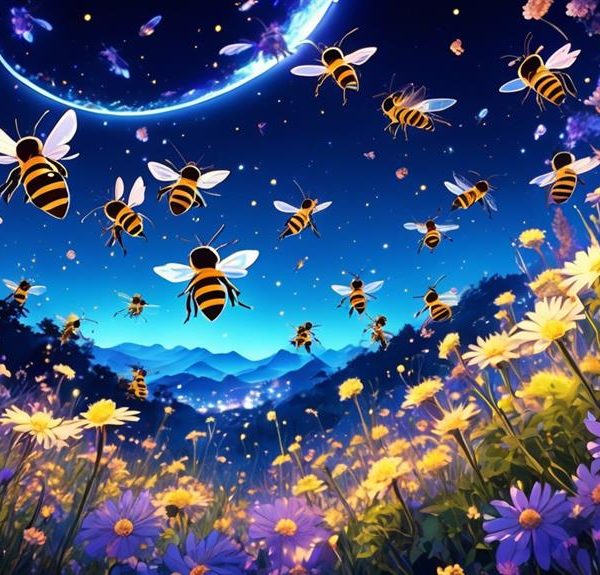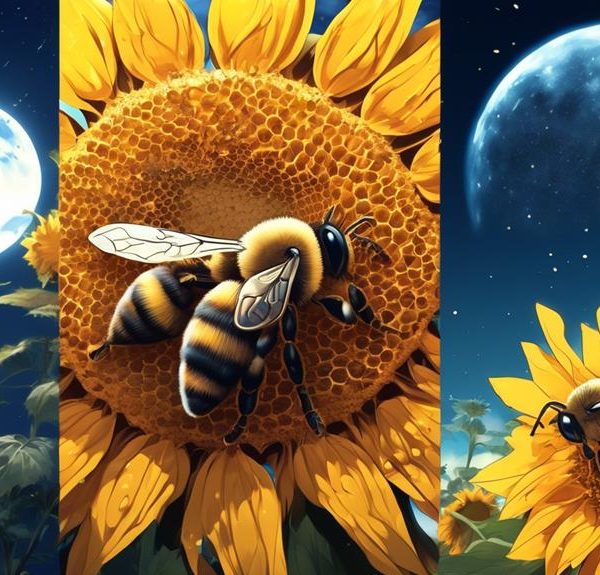Just when you thought you knew everything about bees, the question arises: can these buzzing creatures actually cough?
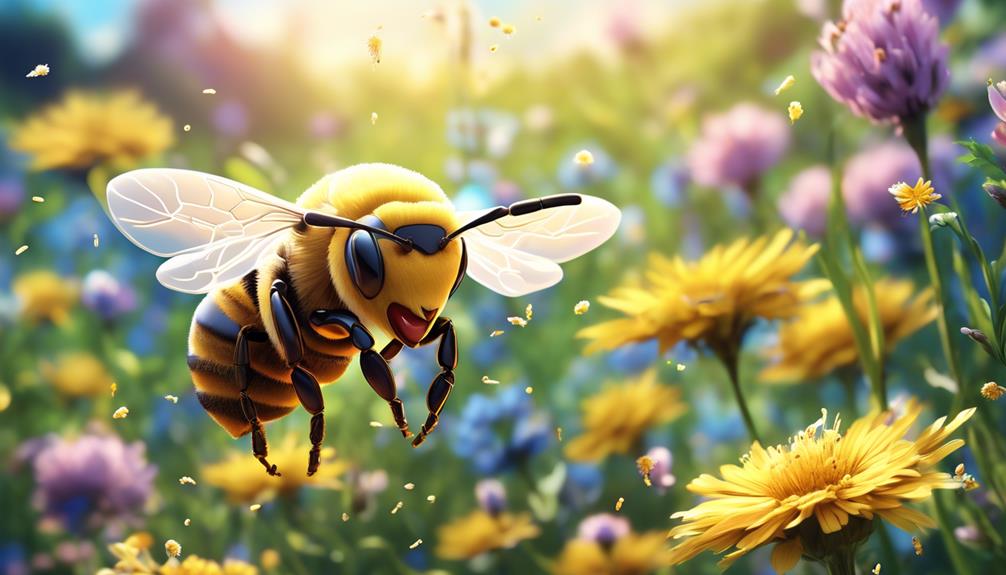
Can Bees Cough?
Imagine, for a moment, you're a bee buzzing through a field of wildflowers on a warm summer day. Suddenly, a tickle in your throat – if you had one – prompts you to cough. Can you? Can bees actually cough?
Before you dismiss this idea as a flight of fancy, consider the intricate and often surprising world of insect physiology. As we explore this fascinating subject, you'll find that the answer to this seemingly absurd question is more complex than you might expect, and it may entice you to question what you thought you knew about our buzzing friends.
Key Takeaways
- Bees do not have a cough reflex because they have a simpler and more efficient tracheal respiratory system.
- Bees communicate through various methods such as the waggle dance, vibrations, and pheromones.
- Understanding bee behavior is important for their role in pollination and conservation efforts.
- Bee behavior reflects their adaptation and survival strategies in the hive.
Understanding Bee Anatomy
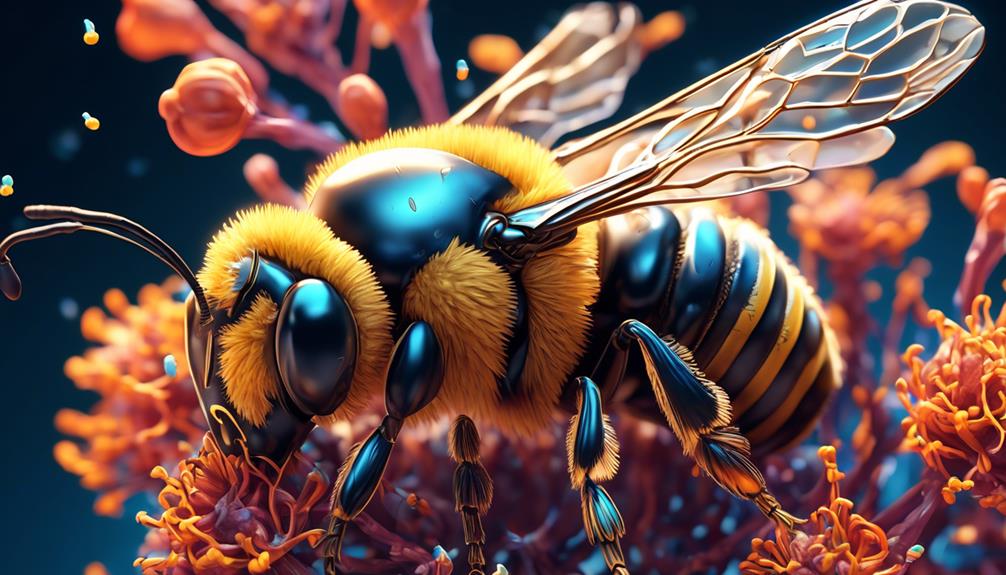
To truly grasp whether bees can cough, you must first delve into the intricacies of their anatomy. Unlike humans, bees don't have lungs. Instead, they breathe through a network of tiny tubes, known as tracheae. Air enters the tubes through external openings called spiracles and oxygen is delivered directly to their cells.
At this point, you might be thinking, 'No lungs, no cough.' However, it's not quite that simple. Humans cough to clear away irritants or mucus from the throat and respiratory tract. Bees, on the other hand, don't produce mucus, so there's nothing to cough up. Yet, they do encounter air pollutants, like dust and pollen, which could potentially clog their tracheae.
Now, here's where things become interesting. Bees can close their spiracles when they're exposed to harmful substances, a mechanism similar to humans holding their breath. Moreover, they can even perform a sort of cleaning process, termed 'grooming', to get rid of these pollutants. Yet, whether we can equate this to a 'bee cough' is still up for debate.
It's clear that bees have their own unique, efficient respiratory system, but it's fundamentally different from ours.
The Respiratory System of Bees
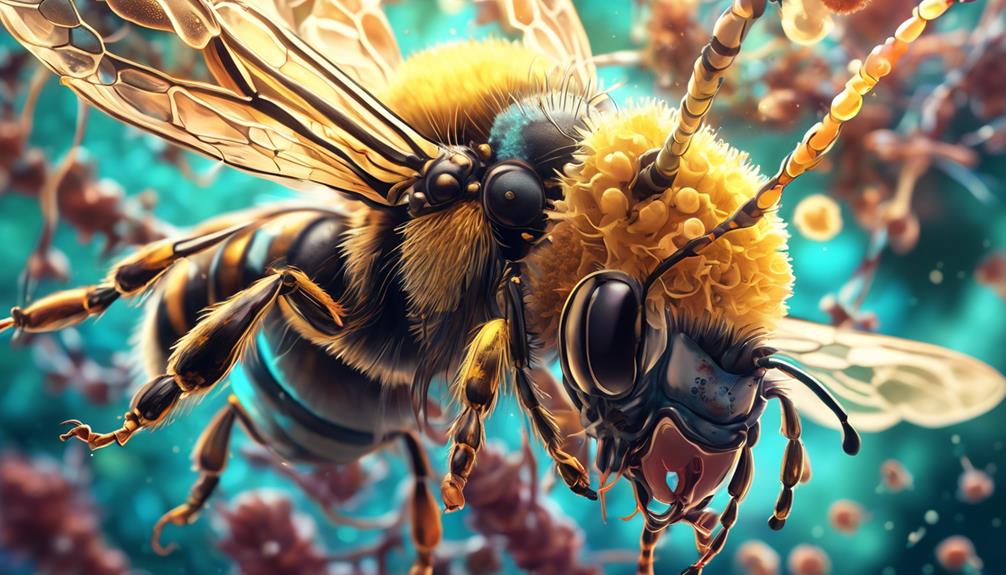
Diving into the realm of bee's respiratory system, you'll find it's a fascinating labyrinth of tracheae, much more complex than you might initially believe. Unlike humans, bees don't possess lungs. Instead, they breathe through a network of tiny tubes called tracheae. The air enters the bee's body through spiracles, small openings located along the sides of the abdomen and thorax.
Inside, this network of tracheae branches out, delivering oxygen directly to the bee's tissues. You'd be interested to know that the oxygen transport occurs passively, without the need for a pumping heart. This system is incredibly efficient, ensuring the bee's high metabolic demands are met.
Now, you might wonder, can bees cough like humans? The answer is no. Coughing is a mechanism to clear the human airways which involve lungs, a component bees lack. Their tracheal system, despite being highly sophisticated, doesn't have a similar mechanism. Instead, bees expel waste materials through their exoskeleton.
Bee Communication Methods
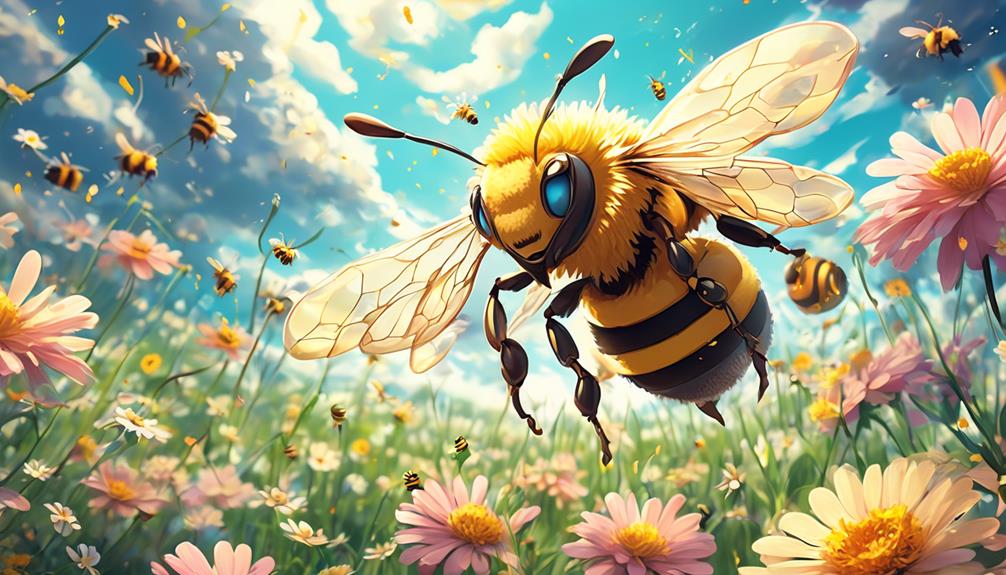
In the bustling hive life, bees demonstrate a sophisticated array of communication methods that are as intriguing as their respiratory system. They employ a range of signals and movements to share information with their hive mates. This includes waggle dances, vibrations, and the use of pheromones.
Consider the following table:
Method | Description | Purpose |
|---|---|---|
Waggle Dance | A figure-eight dance performed by the worker bee | To show the direction and distance of a food source |
Vibrations | Tremble signals or vibrations made by the worker bees | An urgent call to mobilize other bees |
Pheromones | Chemical signals released by bees | To mark trails, attract mates, signal danger or maintain social order |
The waggle dance, for example, is a form of symbolic language. You'll see a bee 'dancing' in figure-eight patterns, using the angle and duration of the dance to indicate the direction and distance of a food source. Vibrations, on the other hand, are a call to action. Bees use these signals to mobilize others, particularly in times of threat. Lastly, pheromones are a key method of communication, used for everything from trail marking to social order maintenance.
The Concept of Coughing in Insects
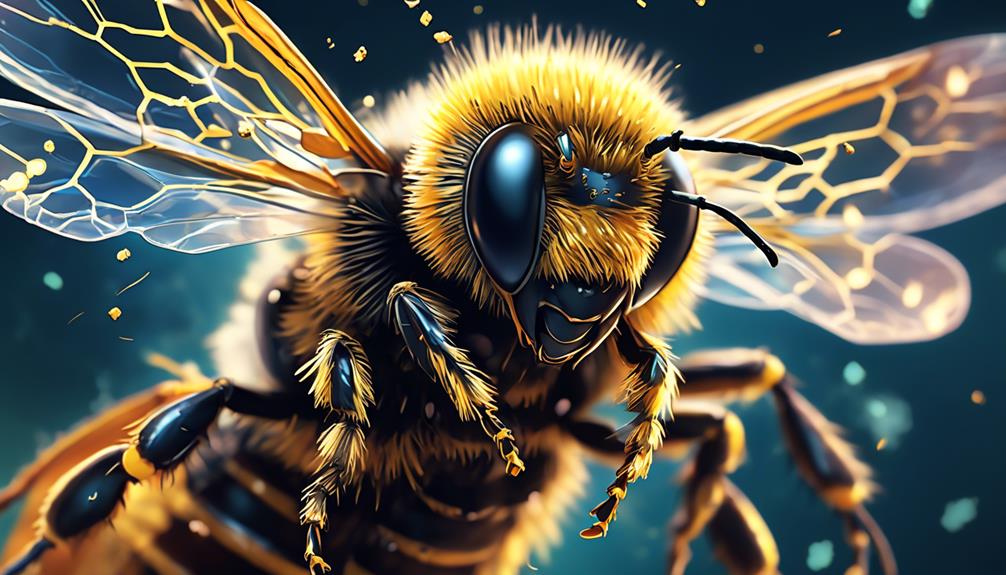
Surprisingly, the concept of coughing as we understand it doesn't really apply to insects, including bees. You see, the cough reflex is a protective mechanism associated with a large, complex respiratory system, like that of mammals. As humans, we cough to expel irritants or excess mucus from our lungs and throat.
Insects, however, don't have lungs. They breathe through a series of tubules known as tracheae, which deliver oxygen directly to their cells. It's a far simpler and more efficient system, but it doesn't include a mechanism for coughing.
Unveiling Bee Behavior Mysteries
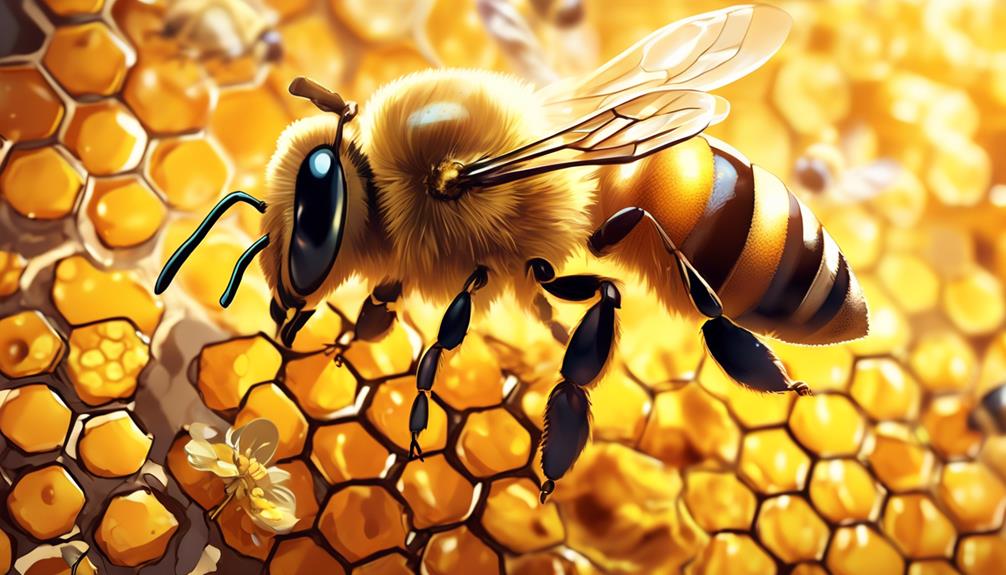
While bees may not have a cough reflex due to their unique respiratory system, they do exhibit a range of intriguing behaviors that continue to fascinate scientists and lead to new discoveries. You'll find bees' social structure particularly captivating.
A hive is a complex society with a strict hierarchy, each bee performing a specific role for the colony's survival. Worker bees, the hive's backbone, carry out various tasks such as foraging for nectar and pollen, building and repairing honeycombs, or feeding the larvae. They communicate through the 'waggle dance', providing information about the direction and distance of food sources.
The queen bee, the colony's only reproductive female, lays up to 2,000 eggs per day during her peak. She produces pheromones that maintain hive unity and worker sterility.
Drones, the males, have one primary role: to mate with a virgin queen. Post mating, they die as their reproductive organs are torn away.
Bee behavior also involves complex defense strategies. When threatened, they use their stingers, releasing a pheromone that alerts others to danger. They've even been observed 'buzzing' at predators in a coordinated way to deter them.
Unraveling these behaviors is key to understanding bees in our ecosystem.
Frequently Asked Questions
Can Bees Contract Human Diseases, Such as the Common Cold or Flu?"
No, bees can't contract human diseases like the common cold or flu. They're insects and their immune systems are vastly different from ours. In fact, they don't even have the same types of cells that viruses such as cold or flu target.
However, bees do face their own set of diseases and parasites that can be just as devastating to their populations.
How Does a Bee's Diet Affect Its Respiratory Health?"
You may wonder how a bee's diet influences its respiratory health.
Well, bees primarily consume nectar and pollen, rich in essential nutrients. If their diet lacks these, it can weaken their immune system, making them susceptible to infections.
Though bees can't cough like humans, a compromised immune system can affect their breathing, impacting their ability to fly and collect food.
Can Environmental Factors Like Pollution or Pesticides Cause Respiratory Issues in Bees?"
Yes, environmental factors like pollution and pesticides can indeed cause respiratory issues in bees.
When you expose bees to pollutants or pesticides, it can damage their respiratory system, making it hard for them to breathe.
Pesticides can also interfere with their ability to smell, which is crucial for finding flowers and communicating with their hive.
Do Bees Have Any Natural Remedies or Behaviors to Deal With Respiratory Problems?"
Well, you're curious if bees have natural remedies or behaviors to cope with respiratory problems. They don't have lungs like us, but they do breathe through tiny tubes called tracheae. If these get blocked, bees can forcibly expel air to clear them, somewhat like a cough.
However, they don't have specific behaviors or remedies to handle respiratory issues as they rely on their hive's overall health and environmental conditions to survive.
What Are the Potential Impacts on the Hive or Bee Population if a Bee Has a Respiratory Condition?"
If a bee suffers from a respiratory condition, it can have a significant impact on the hive. You'd see a decrease in the population as the bee's ability to gather food reduces. It could even spread the condition to other bees, worsening the situation.
Also, the bee's lifespan might shorten, disrupting the hive's daily activities. So, it's clear that a single bee's health can have broader implications for the entire hive's survival and productivity.
Conclusion
So, can bees cough? Well, no. Given their unique anatomy and respiratory system, bees simply don't need to. They communicate differently, not relying on vocal cords or breath.
Coughing, as we understand it, is foreign to their world. This serves as a reminder that despite our attempts to humanize them, bees remain fascinatingly distinct.
Unraveling the mysteries of their behavior continues to baffle and intrigue us, highlighting the diverse wonder of the natural world.

